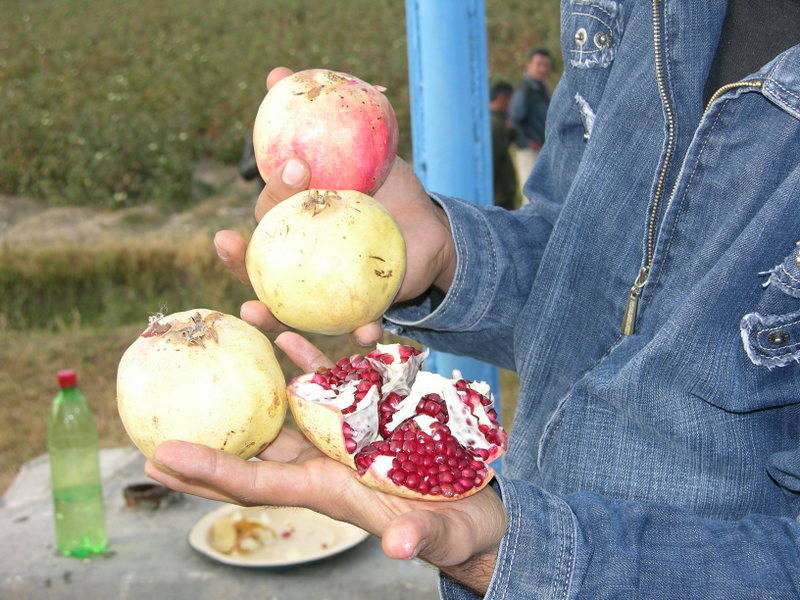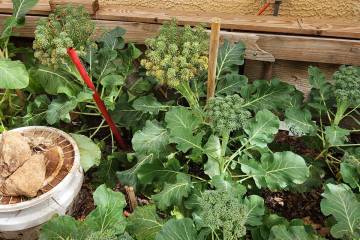Picking time for pomegranates differs with variety
I heard that pomegranates are supposed to be picked around Halloween. Picking them earlier than this results in unripe fruit. That’s not true. The time to pick pomegranates depends on its variety.
It is true the majority of pomegranates are picked around Halloween. That’s because the variety grown is oftentimes the completely red, tart Wonderful variety.
This variety has fruit ready to be harvested around Halloween, but there are varieties of pomegranates that must be picked at other times. One such variety favored in Southern Nevada is called Utah Sweet that ripens and is ready to be harvested around the end of September. Another early variety is called Ambrosia that is ready to be harvested around the beginning of September.
So how do you know if your pomegranate is ready to pick? Look for split fruit. Any time after Sept. 1, the presence of split fruit on the tree can be an indicator that it’s time to begin harvest. You have about three weeks to get fruit off the tree once they are ripe.
Another harvest indicator is how easily the fruit separates from the tree when lifting, turning and pulling them from the branches. If the fruit is relatively easy to remove from the tree, it’s ready to harvest.
Another method is tasting it. Remove a split fruit and sample it before the birds. If it’s sweet, it’s ready to eat.
Some pomegranate fruit is tart and some are not. The variety Wonderful, for instance, is dark red inside and out, and the juice is flavorful but tart. Utah Sweet is not as flavorful but seems sweeter because it lacks the tart flavor. The sugar content of both is the same, but this tart flavor covers up the sweetness of Wonderful.
Some pomegranates are considered to be soft-seeded, again like Utah Sweet, while others, like Wonderful, have hard seeds and they are spit out, or the fruit is juiced and the hard seeds discarded. Know your pomegranate and when it should be harvested before believing they are all the same.
Q: In April of this year, my 20-year-old ash tree had no leaves but instead had a marble-size collection of pods that contain a leafy fluffy branch of tiny leaves. I’m worried about disease on this tree since it provides critical heat protection during the summer. Should I deal with this now or just let the leaves cover it and not worry about it?
A: These are the male flowers of your ash tree and nothing to worry about. These “marbles” will open up, flower, release pollen into the air and disappear until next spring. No disease problems to worry about.
Ash trees are individual male and female. Male trees are available in nurseries since very few people like the female trees due to the massive amounts of seeds they produce and consequently drop to the ground.
The female trees produce similar types of marble-sized flower clusters in the spring but instead produce seed a couple of months later in the year. Mulberry is another type of tree that is individual males and females. The males produce pollen, and the female trees produce fruit.
The primary reason female mulberries were preferred in landscapes is that the dark-colored fruit dropped by birds stained sidewalks, patios and cars. Later, the male trees were planted and contributed to an allergy problem.
Then the male trees were legally banned from many urban communities. The female mulberry trees, which are not banned from most communities, have recently experienced a resurgence due to the interest in local foods.
Most of our landscape and fruit trees flower first and then produce leaves afterward. These trees produce flower buds in the fall that are ready to open before the leaves.
Flowering first provides open spaces for pollinators like honeybees to swarm these flowers, collect their nectar and, in the process, spread the pollen from male to female flowers so that female trees can produce seed. We say that these trees produce their flowers on last year’s wood. Pomegranates and persimmon, as examples, flower after the leaves emerge so they are said to produce flowers on current seasons wood.
Most of our landscape trees enter sexual maturity and begin producing flowers when they are 6 to 8 years old. I am guessing your trees have been producing male flowers for about the last 12 years, but you just haven’t noticed.
Q: I bought a xylosma in 2017 in a 24-inch box that I am training as a single-trunk tree instead of a shrub. It drops its leaves at unusual times. For instance, it dropped its leaves after a heavy snow last February. When can I remove their support poles?
A: Xylosma has a long history of solid performance in Southern Nevada and has been around for a long time. Remember, it is not a desert plant, it’s what we call a “mesic” plant, so it should be irrigated like peaches, apricots or almonds.
Shiny xylosma lost landscape popularity with the advent of desert plants like Texas ranger, Texas laurel and others. It requires regular irrigations and can drop its leaves if it lacks water. It’s still alive, but it can still lose its leaves.
It can also drop leaves any time there is a sudden cold snap, such as a late snowfall or early fall freezing weather. Information published from the warmer Phoenix area might call these plants evergreen. In our slightly colder climate, they are considered semi-deciduous (aka, semi-evergreen), which means the plant keeps its leaves only during warm weather and warm winters. Some mesquite, acacia and palo verde, considered evergreen in warmer climates, will drop their leaves during the colder temperatures of more northern climates like Las Vegas.
As far as removing stakes (support poles as you call them), they are supposed to be removed after one growing season after planting in the ground. If the plants are well-shaped and grown properly at the nursery, this might be possible. Sometimes it’s not and may require some pruning of the top on your part for this to happen.
The pruning I’m talking about is removing some of the top growth (removing entire stems) so it can stand on its own after the stakes are removed. Pruning won’t harm the plant since it will replace what was pruned and grow without supports once it’s in the ground. If it is pruned correctly in the fall, winter or spring, the plant will still look good, but smaller.
Q: An article you previously wrote on Bermuda grass scared a lot of people out of using any type of Bermuda grass for a lawn. I have been growing a Tif-type hybrid bermudagrass and I love it. Please talk about hybrid Bermuda grass for a lawn and give hybrid bermudagrass a fair shake.
A: I’m sorry you saw it that way, but if you follow the advice I give on my blog, podcasts and YouTube videos, you’ll know I don’t like to tell people what they can or can’t grow. Personally, I believe lawns should only be grown on residential property if you have a purpose for them and never as an ornament for a landscape growing in the desert.
In most people’s minds, Bermuda grass is Bermuda grass. However, there is a difference between common Bermuda grass and the more restrained hybrid Bermuda grass. Common Bermuda grass has rampant growth. It is a weed. If not mowed, it spreads allergenic pollen. It is the bad boy of lawn grass.
Hybrid Bermuda grass, like your Tif-type Bermuda grass, has a very simple elegance that is incorporated into golf course greens and tees and gives them a very refined look. They thrive in hot weather and require about 40 percent less water than a typical tall fescue lawn.
The primary reason Bermuda grass, including Tif-type Bermuda grass, has been rejected by homeowners living in Southern Nevada is its winter brown color. This brown color extends all the way through the cool and cold from mid-fall through mid-spring months.
The way around it is to overseed permitted grass around the middle of September with a cooler-season grass to maintain its green color. The other disadvantages of warm-season grasses like hybrid Bermuda grass are its increased requirement for more frequent fertilizer applications; oftentimes a specialized lawnmower is needed and periodic thatch removal.
Bob Morris is a horticulture expert and professor emeritus of the University of Nevada, Las Vegas. Visit his blog at xtremehorticulture.blogspot.com. Send questions to Extremehort@aol.com.























